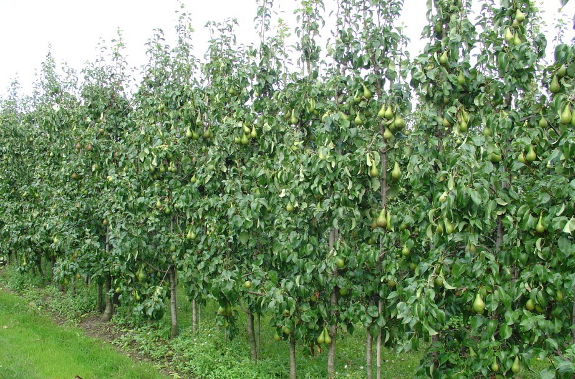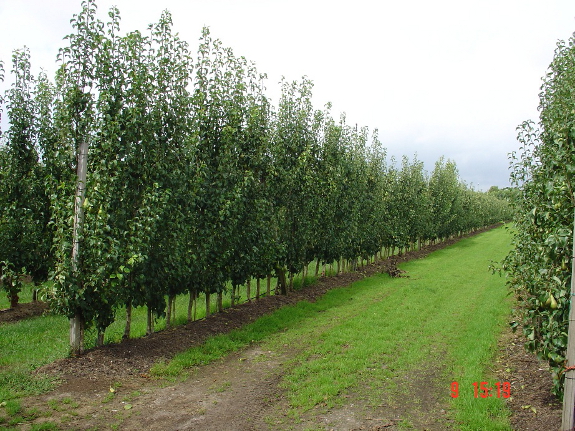
High-density pear trees
In an earlier post, I teased you by saying that next year's high-density
experiment will veer off in an entirely new direction. But, really, it's
the same experiment...just with a different species of tree.
High-density apple
orchards have become big business in the U.S., but at this time, pears
are mostly grown in a more traditional, spaced-out setting. However, one
report I read mentioned that high-density pear plantings are already
common in Europe, suggesting that close plantings can be appropriate for
this other pome as well. Since I have several additional pear varieties that I want to try out
but not enough space for several additional full-size trees, I figured
--- why not experiment with a high-density planting for pears?
The best option for
high-density pear trees appears to be a 4-foot spacing with the limbs
tied down to 45 degrees below the horizontal. To make this work, the
New York State Horticultural Society experimenters recommend using
semidwarf rootstocks like OHF87, which
appeared to be quite acceptable in high-density plantings during the
eight
years of their study (and, the author thought, most likely also for the
entire
life span of the orchard). I ended up buying OHF513 instead for my own
planting since the nursery I wanted to order from uses this
similarly-sized rootstock rather than OHF87, so I guess in a few years
I'll be able to report on how well OHF513 does for high-density
plantings.
There are a few downsides to high-density pear
plantings that aren't a factor when similar strategies are used on apples. First, the
fruits on high-density pear trees tend to be on the small side, and pear
rootstocks also aren't as precocious as those used to dwarf apples. As a
result, the high-density pear researchers found that, even when
planting feathered trees, you really shouldn't expect your first small
pear crop until the third year after planting, and major production
won't begin until the fourth year. If you're starting with rootstocks that you
graft at home, you should add another year onto that figure, meaning
that we probably won't see any pears from our planned row until about
2018.
But what could be more
fun than grafting five little pear trees and setting aside another
garden row for planting out the young trees at this time next year?
Nothing! So, of course, I have to give it a shot.
Want more in-depth information? Browse through our books.
Or explore more posts by date or by subject.
About us: Anna Hess and Mark Hamilton spent over a decade living self-sufficiently in the mountains of Virginia before moving north to start over from scratch in the foothills of Ohio. They've experimented with permaculture, no-till gardening, trailersteading, home-based microbusinesses and much more, writing about their adventures in both blogs and books.
Want to be notified when new comments are posted on this page? Click on the RSS button after you add a comment to subscribe to the comment feed, or simply check the box beside "email replies to me" while writing your comment.



Next to "normal" pears, you might want to look at cooking pears as well.
In the Netherlands the most well-known varieties are "gieser wildeman" and "Saint Rémy" (the latter originated in Belgium).
Cooking pears can be kept for a long time, and of course you can cook them (e.g. with some cinnamon) and can them.
They're also very good in pancakes.